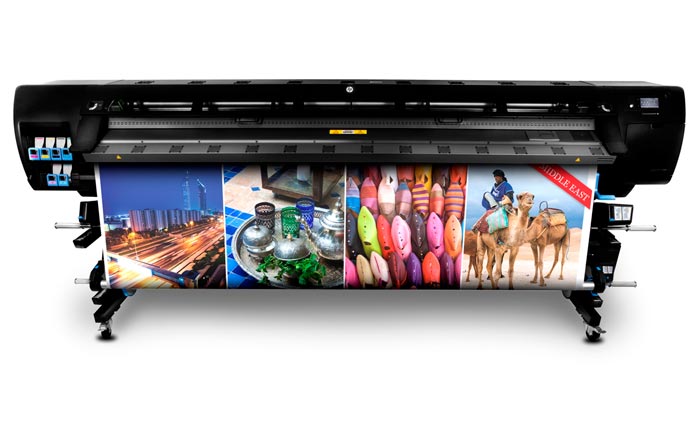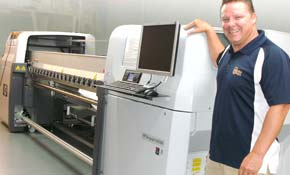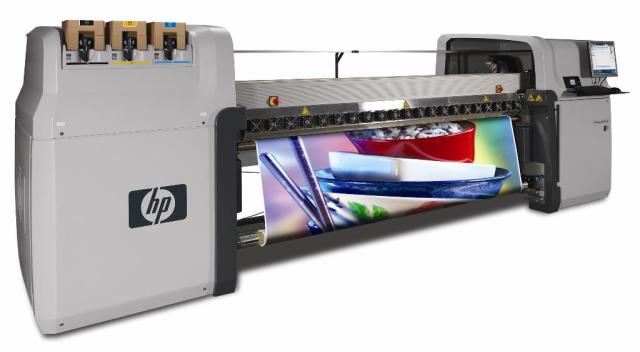
What does it do?
The 2.64m-wide HP Designjet L28500 is the latest model in HP’s range of wide-format digital inkjet machines running water-based latex inks. The machine had its international launch at Fespa alongside the 1.54m-wide L26500 model. It is aimed at the sign and display print business – specifically the soft signage market – but its versatility and ability to print on fabrics means it is also a good fit for the consumer market, with posters, soft furnishings and wall coverings all potential products.
It is compatible with more than 500 substrates, including vinyl, fabrics, paper, film and low-cost uncoated papers for interior and exterior applications.
How does it work?
“The L28500 uses thermal inkjet technology and runs six water-based HP latex inks,” says HP’s sign & display country manager, Zoran Novakovic. “It is suitable for the production of POS, posters, light boxes, wall coverings, soft signage and vehicle graphics, as well as a range of outdoor signage that offers better durability than eco-solvent inks.”
It can print at up to 1,200dpi, which HP claims will offer outdoor display permanence for up to three years if unlaminated or five years if laminated.
How does it differ from the manufacturer’s other models?
“The L28500 is 34% to 70% faster than the L25500, due in part to a faster carriage speed,” says Novakovic.
The maximum print speed of the L28500 is 40m2/hr in four-pass mode, versus 22.8m2/hr on the L26500; in 16-pass mode the print speed falls to 8m2/hr and 6.3m2/hr respectively.
What is its USP?
According to Novakovic, one of its key USPs is its ability to handle a broader range of indoor and outdoor signage applications with better durability than eco-solvent inks. Another is its higher productivity through increased speeds.
“The L28500 features HP’s new double-sided printing workflow; allied with an Optical Media Advance Sensor (OMAS), this enables double-sided printing with minimal operator intervention,” he adds. “The OMAS controls registration auto-matically by locating a registration mark when the printed media is reloaded to print the reverse side.”
The machine features a more robust take-up reel than the original L25500 model – which has now been discontinued – with the L28500 capable of handling up to 100kg. This makes way for longer unattended operation, says HP.
What training and service support is on offer?
HP has a network of certified Designjet resellers that can assist on installation and various training options depending on the end-user’s requirements.
“In addition, users of the L28500 can benefit from the recently-introduced HP Latex University,” says Novakovic. “This is a complimentary initiative that enables users to access a broad set of resources and training materials to help boost competitiveness. They can also use it to market their green credentials.”
“The unique properties of HP Latex inks ensure virtually no VOCs are emitted and no hazardous air pollutants. This has been recognised by Greenguard, which have certified HP Latex Inks for installation into extremely sensitive indoor environments such as hospitals and schools – this certification is a first for our industry.
“There is a growing number of installations of HP Latex prints on HP’s PVC-free wallpaper in Children’s Hospital Wards around Australia, including RPA in Sydney and Princess Margaret in Perth.”
How much does it cost?
HP Australia does not publish price details. As a guide, the UK list price supplied to ProPrint’s UK sister magazine, PrintWeek, was £45,000. Local customers should contact HP Australia for more information.
Specifications
Print width 2,640mm
Speed
70m2/hr (two-pass, bi-directional),
40m2/hr (four-pass, bi-directional)
Colours Six (CMYK, light cyan, light magenta)
Price Undisclosed
Contact HP Australia 1800 508 359 www.hp.com
The Alternative
Mimaki JV400-160LX
Launched earlier this year, the 1.6m specification JV400-160LX features Mimaki’s new latex ink, offers a maximum print speed of 18m2/hr and can output at a top resolution of 900dpi. Although it features a narrower print width, the eight-colour JV400 LX range uses the company’s new latex ink set, which is claimed to use a low curing heat, consuming less energy and enabling the machines to print on a wider range of materials. The JV400
LX machines take advantage of Mimaki’s RasterLink6 RIP software that enables the deposition of three layers of ink in one pass, including
a base layer of white ink for printers that support white ink.
Print width 1,610mm
Max speed 900dpi: 18.1m2/hr; 900×1,200dpi: 14.2m2/hr; 1,200dpi: 11.9m2/hr
Colours (2 x CMYK or CCMMYK plus two whites)
Price $34,995
Contact DGS Mimaki (02) 4272 3663 www.dgsmimaki.com.au
Comment below to have your say on this story.
If you have a news story or tip-off, get in touch at editorial@sprinter.com.au.
Sign up to the Sprinter newsletter


